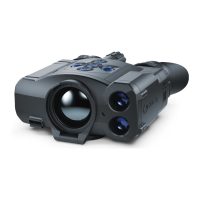8
Activation
•
Press and hold down the button to enter the main menu.
•
Select the menu option with the UP (2)/DOWN (5) buttons.
•
Turn Wi-Fi on/off with a short press of the button.
Image Detail
Boost
Turn on/off Image Detail Boost:
•
Press and hold down the button to enter the main menu.
•
Select the Image Detail Boost menu option with the UP (2)/DOWN (5) buttons.
•
Turn Image Detail Boost on/off with a short press of the button.
Mode
The devices have four observation modes of the thermal imager: (observation mode of
objects within low thermal contrast conditions), (observation mode of objects within
high thermal contrast conditions), (high detalization mode), User (individual
brightness and contrast settings).
•
Press and hold the button to enter the menu.
•
Select the Mode option with the UP (2)/DOWN (5) buttons.
•
A short press of the button opens the menu.
•
Select one of the settings described below with the UP (2)/DOWN (5) buttons.
•
A short press of the button conrms the selection.
This is the best mode when searching and observing within eld conditions,
against the background of leaves, bushes and grass. The mode is highly
informative about an object being observed as well as landscape details.
This is the best mode when observing objects after a sunny day or within
urban conditions.
This is the best mode when observing objects within adverse weather
conditions (fog, mist, rain and snow). It allows you to recognize the
characteristics of an object being observed more clearly. Zoom increase may
be accompanied by insignicant image graininess.
User
It allows you to congure and save custom brightness and contrast settings,
as well as one of the three modes as basic.
Note: to quickly change observation modes press and hold the DOWN (5) button.
Icon
Brightness
•
Press and hold the button to enter the main menu.
•
Use the UP (2)/DOWN (5) buttons to select the Icon Brightness icon .
•
Press the button briey to enter the submenu.
•
Use the UP (2)/DOWN (5) buttons to select the desired brightness level from 0 to 10.
•
Press the button briey to conrm the selection.
Color Modes Default color mode is White Hot.
To select another palette:
•
Press and hold down the button to enter the main menu.
•
Select the Color Modes icon with the UP (2)/DOWN (5) buttons.
•
Press briey the button to enter submenu.
•
Select the desired palette with the UP (2)/DOWN (5) buttons.
•
Conrm your selection with a brief press of the button.
(white color corresponds to low temperature, black color – to high temperature)
- Red Hot
- Red Monochrome
- Rainbow
- Ultramarine
- Violet
- Sepia
Note: to quickly change color modes press and hold the UP (2) button.
Calibration
Mode
There are three calibration modes: manual (M), semi-automatic (SA) and automatic .
•
Press and hold down the button to enter the main menu.
•
Select the Calibration Mode option with the UP (2)/DOWN (5) buttons.
•
Press briey the button to enter submenu.
•
Select the desired calibration mode with the UP (2)/DOWN (5) buttons.
•
Conrm your selection with a brief press of the button.
More details in the section Microbolometer Calibration.
PiP Mode
Selection of the Picture in Picture Mode:
•
Press and hold the button to enter the menu.
•
Select the PiP Mode option with the UP (2)/DOWN (5) buttons.
•
A short press of the button switches the mode on/off.

